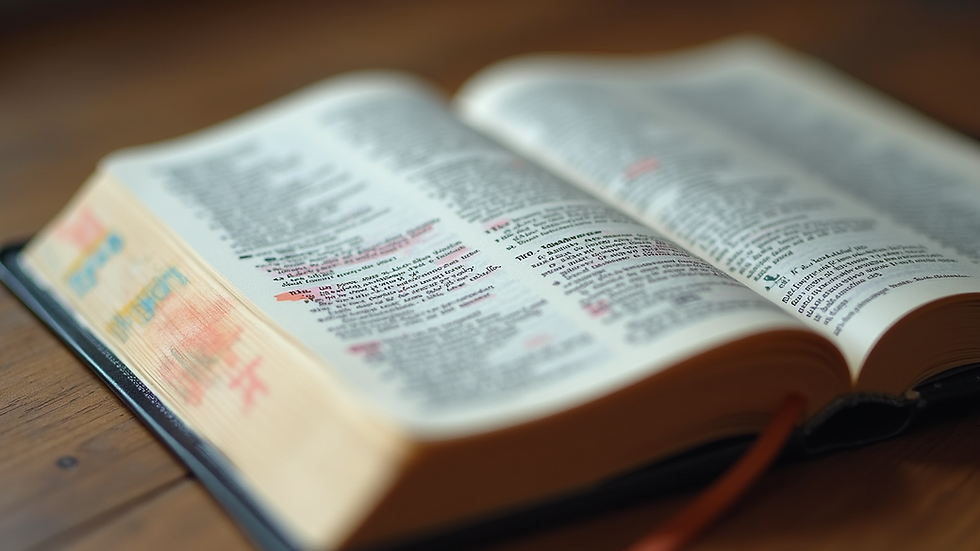Uncovering the Origins of the NLT Bible Translation: A Journey into the Who, What, and When
- Joy Creative Bibles

- Feb 6
- 4 min read
Navigating the pages of the Bible can sometimes feel daunting, especially with the complex language of older translations. That's where the New Living Translation (NLT) comes into play, aiming to bridge the gap between ancient texts and modern readers. This translation is loved for its clarity, making Scripture accessible for everyone—from curious newcomers to deeply rooted believers. But what sparked its creation? Who were the driving forces behind it, and when did it all start? Let’s dive into the origins of the NLT and uncover the key moments that shaped this influential translation.
The Need for a New Translation
In the late 20th century, many found existing Bible translations challenging to read. For instance, studies showed that nearly 70% of people felt the language of traditional translations was outdated. This disconnect led readers to seek a version that communicated the essential messages of Scripture in a way they could easily grasp.
Responding to this need, Tyndale House Publishers saw a significant opportunity. They aimed to create a translation that resonated with a broader audience, including those who may have struggled with traditional texts. This understanding set the stage for the NLT, emphasizing readability while staying true to biblical truths.
Key Figures Involved in the NLT Translation
At the heart of the NLT project were passionate scholars and linguists committed to producing an accurate yet approachable translation. One pivotal figure was Dr. Kenneth N. Taylor, the founder of Tyndale House. His journey began in the 1960s when he simplified biblical texts for his children. This endeavor culminated in the publication of "The Living Bible" in 1971, which became a bestseller and demonstrated the demand for a more accessible Bible.
The success of "The Living Bible" laid the groundwork for a new scholarly effort. Taylor and a team of experts sought to create a formal translation—one that would not only maintain the integrity of the original texts but also hold up under academic scrutiny.
The Collaborative Effort
The NLT translation became a reality in the 1980s through an extensive collaboration of linguists and biblical scholars from diverse backgrounds. The project's primary objective was to create a translation that balanced fidelity to the original texts with a style that spoke to contemporary readers.
The New Living Translation Committee formed to ensure a comprehensive approach. Each member brought unique expertise, combining knowledge of biblical languages, literature, and theology. For instance, experts in Hebrew performed careful examinations of Old Testament texts while Greek scholars focused on the New Testament, ensuring that every nuance was captured accurately.
The Process of Translation
The process to translate the NLT was thorough and deliberate. The translators worked directly from the original Hebrew and Greek manuscripts, utilizing a thought-for-thought method known as dynamic equivalence. This approach emphasizes conveying ideas rather than sticking rigidly to word-for-word translations.
Drafts underwent numerous revisions, incorporating feedback from committee members and external reviewers. This collaborative effort was crucial for refining the text, ensuring it was not just accurate but also easy to read and understand.
Publication of the NLT
The first complete edition of the New Living Translation was published in 1996, which marked a watershed moment in modern Bible translations. It quickly attracted a broad audience, including casual readers and scholars alike. Initial reviews were overwhelmingly positive; readers lauded the translation's clarity, saying it felt less like reading an ancient document and more like engaging in a conversation.
By the end of the first year, the NLT was already making significant inroads in churches across the U.S., enhancing its reputation and popularity among various faith communities.
Subsequent Revisions
After the initial release, the NLT continued to evolve. A notable revision arrived in 2004. This update refined the language even further and included cross-references and footnotes to deepen understanding. The revision process has been an ongoing commitment to improvement, with additional editions released in formats such as study Bibles and digital versions to cater to an ever-growing audience.
The flexibility of the NLT, which has seen more than 25 million copies sold to date, speaks volumes about its relevance in today’s society.
The Impact of the NLT Translation
The New Living Translation has transformed how many engage with Scripture. Its accessible language has opened doors for countless individuals to connect with biblical teachings on a personal level. Surveys indicate that over 80% of regular churchgoers report using the NLT in their studies and discussions. This translation has fostered an inclusive atmosphere, encouraging everyone—especially those new to Christianity—to explore the Scriptures freely.
Ministries and churches frequently incorporate the NLT into their teachings, leading to a richer understanding of biblical principles and promoting discussions that resonate deeply with congregants.
Reflecting on the Journey of the NLT
The journey of the New Living Translation embodies a profound dedication to making Scripture accessible. It began with Kenneth N. Taylor's vision and blossomed through collaborative efforts by scholars committed to clarity and accuracy. The NLT does not just invite readers to explore a text; it allows them to engage with the core truths of faith in a relatable way.
Whether you're reading the Bible for the first time or revisiting beloved passages, the NLT stands as a testament to language's power in bringing people closer to the message of Scripture. With each page, it invites you to experience the profound narratives that have shaped millions of lives throughout history.



Comments